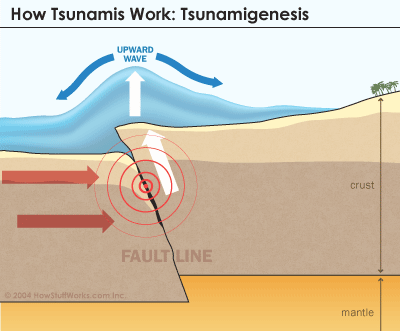
PHYSICS OF TSUNAMIS (TSUNAMİ FİZİĞİ)
Contents – İçerik
1 General Information on Tsunami Waves, Seaquakes and Other Catastrophic Phenomena in the Ocean
1.1 Tsunami: Definition of Concepts
1.2 Manifestations of Tsunami Waves on Coasts
1.3 Tsunami Magnitude and Intensity
1.4 Tsunami Warning Service: Principles and Methods
1.5 Databases and Tsunami Statistics
1.6 Seaquakes: General Ideas
1.7 Hydroacoustic Signals in the Case of Underwater Earthquakes
1.8 Killer Waves in the Ocean
References
2 Physical Processes at the Source of a Tsunami of Seismotectonic Origin
2.1 Seismotectonic Source of a Tsunami: The Main Parameters and Secondary Effects
2.1.1 TheMain Parameters
2.1.2 Secondary Effects
2.1.3 Calculation of Deformations of the Ocean Bottom
2.2 General Solution of the Problem of Excitation of Gravitational Waves
in a Layer of Incompressible Liquid by Deformations of the Basin Bottom
2.2.1 Cartesian Coordinates
2.2.2 Cylindrical Coordinates
2.3 Plane Problems of Tsunami Excitation by Deformations of the Basin Bottom
2.3.1 Construction of the General Solution
2.3.2 Piston and Membrane Displacements
2.3.3 Running and Piston-like Displacements
2.3.4 The Oscillating Bottom
2.4 Generation of Tsunami Waves and Peculiarities of the Motion of Ocean Bottom at the Source
References
3 Role of the Compressibility of Water and of Non-linear Effects in the Formation of Tsunami Waves
3.1 Excitation of TsunamiWaves with Account of the Compressibility of Water
3.1.1 Preliminary Estimates
3.1.2 General Solution of the Problem of Small Deformations of the Ocean Bottom Exciting Waves in a Liquid
3.1.3 Piston and Membrane Displacements
3.1.4 The Running Displacement
3.1.5 Peculiarities of Wave Excitation in a Basin of Variable Depth
3.1.6 Elastic Oscillations of the Water Column at the Source of the Tokachi-Oki Tsunami, 2003
3.2 Non-linear Mechanism of Tsunami Generation
3.2.1 Base Mathematical Model
3.2.2 Non-linear Mechanism of Tsunami Generation by Bottom Oscillations in an Incompressible Ocean
3.2.3 Non-linear Tsunami Generation Mechanism with Account of the Compressibility of Water
References
4 The Physics of Tsunami Formation by Sources of Nonseismic Origin
4.1 Tsunami Generation by Landslides
4.2 Tsunami Excitation Related to Volcanic Eruptions
4.3 Meteotsunamis
4.4 Cosmogenic Tsunamis
References
5 Propagation of a Tsunami in the Ocean and Its Interaction with the Coast
5.1 Traditional Ideas Concerning the Problem of Tsunami Propagation
5.2 Numerical Models of Tsunami Propagation
5.3 Tsunami Run-up on the Coast
References
6 Methods of Tsunami Wave Registration
6.1 Coastal and Deep-water Measurements of Sea Level
6.2 Geomorphological Consequences of Tsunami: Deposits of Paleotsunamis
6.3 Tsunami Detection in the Open Ocean by Satellite Altimetry
References
7 Seaquakes: Analysis of Phenomena and Modelling
7.1 Manifestations of Seaquakes: Descriptions by Witnesses and Instrumental Observations
7.1.1 Historical Evidence
7.1.2 Analysis of Historical Testimonies and the Physical Mechanisms of Vertical Exchange
7.1.3 Instrumental Observations of Variations of the Ocean’s Temperature Field After an Earthquake
7.2 Estimation of the Possibility of Stable Stratification Disruption in the Ocean Due to an Underwater Earthquake
7.3 Parametric Generation of Surface Waves in the Case of an Underwater Earthquake
7.4 Experimental Study ofWave Structures and of Stable Stratification Transformation in a Liquid in the Case of Bottom Oscillations
References
Colour Plate Section
Index

You always do the right thing. God Bless you.
Thank you
Thank you 🙂